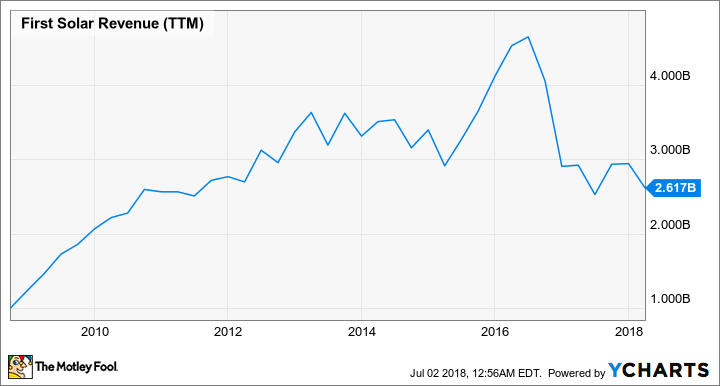First Solar, Inc. in 3 Charts
First Solar, Inc. (NASDAQ: FSLR) has been one of the most successful solar companies of the past decade, but it hasn't been a long-term winner for investors. Shares are down 80% in the past decade, while shares are up 33% in the past year, evidence that there's a lot of volatility in the stock.
To understand First Solar's ups and downs, we need to understand the challenges solar panel manufacturers face. Here are three charts showing some of the ups and downs of solar manufacturing, and where First Solar fits into the industry.

Image source: First Solar.
Growth without growing
First Solar is consistently expanding manufacturing capacity in order to grow its business, but that hasn't necessarily meant revenue growth. You can see below that revenue is basically flat since 2013, despite production rising from 1.6 gigawatts (GW) in 2013 to a peak of 3.1 GW in 2016, which seems odd on the surface.
FSLR Revenue (TTM) data by YCharts.
Revenue is stagnant because solar panel prices are dropping rapidly. In late 2013, PVInsights reported that commodity solar panels sold for about $0.70 per watt, about double the price panels are going for today. Growing production is essentially just allowing companies to keep revenue flat, not grow.
Gross margin is all over the map
The chart below shows just a little bit of the volatility solar companies see on a regular basis. You can see that First Solar has generated net income for most of the past decade, but there have been some big losses as well as the company wrote down assets and upgraded manufacturing processes.
FSLR Gross Profit Margin (TTM) data by YCharts.
The most notable item in the chart above is the blue line, which shows gross margin each quarter. In 2008 and 2009, gross margin figures regularly exceeded 50%, a mark the company hasn't come close to in recent years.
The decline in margin has been due to competitive pressures from commodity solar panels, primarily produced in Asia. These panels are more efficient than First Solar's thin-film technology at turning the sun's energy into electricity. In the early part of this decade, the cost of these panels plunged rapidly. First Solar had to respond by lowering prices, which impacted both revenue and gross margin negatively.
We're seeing similar trends in 2018 due to an oversupply of solar panels across the globe. Roth Capital estimates that by the end of 2018, the market will be oversupplied by 34 GW, which is pushing panel prices lower. Bloomberg New Energy Finance estimates that high-end Chinese solar panel prices will drop 34% in 2018, and that'll force First Solar to respond with lower prices. As encouraging as the rising margin have been recently, we may be in for a downward slide in margin again later this year.
First Solar's biggest advantage
As much as the revenue and margin trends long term have been a challenge for First Solar, the company has always been able to fall back on a rock-solid balance sheet. The chart below shows the company's cash level rising to $1.9 billion as of the end of the first quarter of 2018, offset by just $438 million of debt, which is backed by project developments.
FSLR Cash and Equivalents (Quarterly) data by YCharts.
This balance sheet allows First Solar to adjust its strategy to maximize value long term. Sometimes this means by developing projects on its own; at other times, it means investing in wider manufacturing capacity. While most solar manufacturers are trying to dig their way out of debt, First Solar is sitting on a mountain of cash, which is always a nice position to be in.
What's next for First Solar?
Right now, First Solar is at the high point of one of the industry's cycles, experiencing strong bookings and high margins. But recent decisions to cut solar incentives in China will hinder the industry and it's starting to lead to a sharp drop in solar panel prices. If history is any guide, First Solar can expect margins to decline as a result of the competitive pressure, and even a growing manufacturing base may not lead to top-line growth. As has been the case for a decade, it may be tough for investors to make a great return on this solar manufacturer in this highly competitive industry.
More From The Motley Fool
Travis Hoium owns shares of First Solar. The Motley Fool recommends First Solar. The Motley Fool has a disclosure policy.



